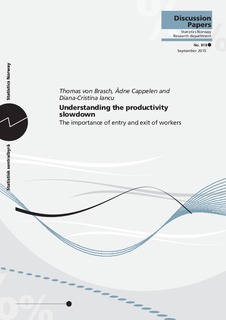Understanding the productivity slowdown The importance of entry and exit of workers
| dc.contributor.author | Brasch, Thomas von | |
| dc.contributor.author | Cappelen, Ådne | |
| dc.contributor.author | Iancu, Diana-Cristina | |
| dc.coverage.spatial | Norway | nb_NO |
| dc.date.accessioned | 2019-07-29T10:34:02Z | |
| dc.date.available | 2019-07-29T10:34:02Z | |
| dc.date.issued | 2015-09 | |
| dc.identifier.issn | 1892-753X | |
| dc.identifier.uri | http://hdl.handle.net/11250/2606610 | |
| dc.description.abstract | Many OECD countries have experienced a slowdown in measured labour productivity from 2005 and onwards. Norway is no exception in this respect. Most countries use a simple aggregate of hours worked when measuring labour productivity. One way to improve measurement of labour services is to control for worker characteristics. A theoretical rationale for doing so is given by Diewert and Lippe (2010). We generalise previous analyses by allowing for exit and entry of workers when measuring labour services using Norwegian microdata. We find that the bias from using hours worked compared to a labour index capturing various compositional effects can be substantial and systematic over time. In the case of Norway the bias explains about a quarter of the productivity slowdown after 2005. | nb_NO |
| dc.language.iso | eng | nb_NO |
| dc.publisher | Statistisk sentralbyrå | nb_NO |
| dc.relation.ispartofseries | Discussion papers;818 | |
| dc.subject | Labour productivity | nb_NO |
| dc.subject | Arbeidsproduktivitet | nb_NO |
| dc.subject | Index numbers | nb_NO |
| dc.subject | Unit value indices | nb_NO |
| dc.subject | Drobish index | nb_NO |
| dc.subject | Drobishindeks | nb_NO |
| dc.title | Understanding the productivity slowdown The importance of entry and exit of workers | nb_NO |
| dc.type | Working paper | nb_NO |
| dc.description.version | publishedVersion | nb_NO |
| dc.source.pagenumber | 35 s. | nb_NO |
Tilhørende fil(er)
Denne innførselen finnes i følgende samling(er)
-
Discussion Papers [1003]
